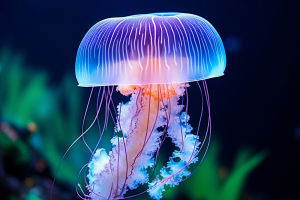Otters Hold Hands in Sleep
Imagine drifting off to sleep while floating on your back, the water gently rocking beneath you. Now imagine you might float away in your sleep—and never see your loved ones again. That's the challenge sea otters face every single day.
Their solution? They hold hands. And while it may seem heartwarming or even a little silly at first glance, it's actually a smart, evolved behavior with serious survival value.
Yes, otters really do float around holding hands—but there's more to the story than viral videos and adorable photos. It turns out, this habit is rooted in ecology, physics, and deep social bonding.
Staying Together in a Moving World
Sea otters often sleep while floating in open waters, especially among kelp forests off the Pacific coasts of North America, where the water is deep, the current is strong, and the ocean is unpredictable. If they were to drift off—literally—they could end up separated from their group or even swept toward the wrong way.
That's where hand-holding comes in.
1. Physical Anchoring
Otters don't just float—they're buoyant. Their thick fur traps air and helps them stay above the surface. But buoyancy comes with a downside: it makes them especially vulnerable to water currents. To avoid drifting apart while napping, otters grip each other's paws to stay tethered.
2. Kelp Ties as Backup
Otters also anchor themselves by wrapping their bodies in long strands of kelp. But kelp can tear, shift, or grow too far apart. Holding hands adds a biological safety net, making sure no one floats off on their own—even if their kelp fails them.
Not Just Survival—It's Also Emotional
While the need to stay together is a matter of safety, the act of holding hands also speaks volumes about otters' social lives.
1. Strong Social Bonds
Otters are known for forming close family units, especially between mothers and pups. A mother otter will cling to her baby's paw or chest while they sleep, creating not only physical security but emotional reassurance. This touch helps soothe young pups and reinforces the mother-infant bond.
2. Group Trust
In larger "rafts" of otters—groups of sleeping individuals—holding hands builds a network of trust. You're not just physically linked to another body; you're relying on them to be still, calm, and alert if a problem arises. It's a quiet show of interdependence.
The Science Behind Otter Touch
Researchers studying sea otter behavior, including marine biologists from institutions like the Monterey Bay Aquarium and the University of California, have confirmed that tactile interaction is a key part of otter communication. It goes far beyond hand-holding during naps.
1. Grooming Together
Otters spend hours grooming their fur to maintain its insulating properties. During this time, they also touch, nuzzle, and even "chat" in soft vocal tones. This grooming reinforces group bonds and helps maintain social structure.
2. Teaching the Young
A mother otter doesn't just protect her pup—she teaches it. From how to groom fur to cracking open shellfish with rocks, the pup learns by watching and through physical demonstration. Holding hands during rest gives the young otter time to feel safe and stay close, which is vital during these early lessons.
Why This Matters for Conservation
Understanding behaviors like hand-holding isn't just charming—it's important for keeping otters alive. Sea otters are a keystone species, meaning their presence helps maintain the balance of marine ecosystems, especially kelp forests. But they've faced sharp population declines due to habitat loss, pollution, and human interference.
When conservationists protect otters, they pay attention not just to population size but also to behaviors like:
• Whether mothers and pups are sticking together
• Whether otters are forming healthy sleeping rafts
• How often otters are seen holding paws during rest
These signs offer insight into the social health of the population, not just the numbers.
So next time you see a picture of two otters holding hands, know that it's not just cute—it's clever. It's protective. It's a little touch that says, "I've got you," in a world where floating away could mean floating alone forever.
Isn't it amazing how much can be said with a single gesture—even from an animal? What's another animal behavior you've always thought was just cute, but might actually hide a deeper purpose? Let's unpack it together.
-
 Magic in the Moonlit DeepLight from life? Dive into the dazzling mystery of bioluminescence—where creatures sparkle in the shadows of land and sea!
Magic in the Moonlit DeepLight from life? Dive into the dazzling mystery of bioluminescence—where creatures sparkle in the shadows of land and sea! -
 Metamorphosis: Nature' MagicFrom crawling to flying—can one life hold many forms? Explore jaw-dropping animal transformations you won't believe are real!
Metamorphosis: Nature' MagicFrom crawling to flying—can one life hold many forms? Explore jaw-dropping animal transformations you won't believe are real! -
 Metamorphosis: Nature' MagicFrom crawling to flying—can one life hold many forms? Explore jaw-dropping animal transformations you won't believe are real!
Metamorphosis: Nature' MagicFrom crawling to flying—can one life hold many forms? Explore jaw-dropping animal transformations you won't believe are real!
Contact to : xyjph123@gmail.com
Privacy Agreement
Copyright © boyuanhulian 2020 - 2022. All Right Reserved.
Privacy Agreement
Copyright © boyuanhulian 2020 - 2022. All Right Reserved.